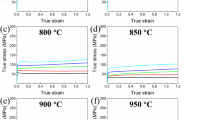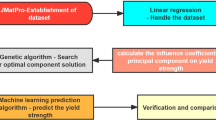Abstract
It is difficult to rapidly design the process parameters of copper alloys by using the traditional trial-and-error method and simultaneously improve the conflicting mechanical and electrical properties. The purpose of this work is to develop a new type of Cu-Ni-Co-Si alloy saving scarce and expensive Co element, in which the Co content is less than half of the lower limit in ASTM standard C70350 alloy, while the properties are as the same level as C70350 alloy. Here we adopted a strategy combining Bayesian optimization machine learning and experimental iteration and quickly designed the secondary deformation-aging parameters (cold rolling deformation 90%, aging temperature 450°C, and aging time 1.25 h) of the new copper alloy with only 32 experiments (27 basic sample data acquisition experiments and 5 iteration experiments), which broke through the barrier of low efficiency and high cost of trial-and-error design of deformation-aging parameters in precipitation strengthened copper alloy. The experimental hardness, tensile strength, and electrical conductivity of the new copper alloy are HV (285 ± 4), (872 ± 3) MPa, and (44.2 ± 0.7)% IACS (international annealed copper standard), reaching the property level of the commercial lead frame C70350 alloy. This work provides a new idea for the rapid design of material process parameters and the simultaneous improvement of mechanical and electrical properties.
Similar content being viewed by others
References
Z. Li, Z. Xiao, Y.B. Jiang, Q. Lei, and J.X. Xie, Composition design, phase transition and fabrication of copper alloys with high strength and electrical conductivity, Chin. J. of Nonferrous Met., 29(2019), No. 9, p. 2009.
L. Jiang, H.D. Fu, C.S. Wang, W.D. Li, and J.X. Xie, Enhanced mechanical and electrical properties of a Cu-Ni-Si alloy by thermo-mechanical processing, Metall. Mater. Trans. A, 51(2020), No. 1, p. 331.
H.D. Fu, S. Xu, W. Li, J.X. Xie, H.B. Zhao, and Z.J. Pan, Effect of rolling and aging processes on microstructure and properties of Cu-Cr-Zr alloy, Mater. Sci. Eng. A, 700(2017), p. 107.
H.T. Zhang, Y.B. Jiang, J.X. Xie, Y.H. Li, and L.J. Yue, Precipitation behavior, microstructure and properties of aged Cu-1.7 wt% Be alloy, J. Alloys Compd., 773(2019), p. 1121.
Z.L. Zhao, Z. Li, Z. Xiao, M.Z. Ma, and K.R. Song, Dynamic recrystallization of Cu-Cr-Ni-Si-Co alloy during hot deformation, JOM, 73(2021), No. 8, p. 2274.
R. Monzen and C. Watanabe, Microstructure and mechanical properties of Cu-Ni-Si alloys, Mater. Sci. Eng. A, 483–484(2008), p. 117.
J. Li, G.J. Huang, X.J. Mi, L.J. Peng, H.F. Xie, and Y.L. Kang, Relationship between the microstructure and properties of a peak aged Cu-Ni-Co-Si alloy, Mater. Sci. Technol., 35(2019), No. 5, p. 606.
U. Bhandari, C.Y. Zhang, S.M. Guo, and S.Z. Yang, First-principles study on the mechanical and thermodynamic properties of MoNbTaTiW, Int. J. Miner. Metall. Mater., 27(2020), No. 10, p. 1398.
Z.S. Nong, H.Y. Wang, and J.C. Zhu, First-principles calculations of structural, elastic and electronic properties of (TaNb)0.67(HfZrTi)0.33 high-entropy alloy under high pressure, Int. J. Miner. Metall. Mater., 27(2020), No. 10, p. 1405.
J. Li, G.J. Huang, X.J. Mi, L.J. Peng, H.F. Xie, and Y.L. Kang, Influence of the Ni/Co mass ratio on the microstructure and properties of quaternary Cu-Ni-Co-Si alloys, Materials, 12(2019), No. 18, art. No. 2855.
J.Z. Huang, Z. Xiao, J. Dai, Z. Li, H.Y. Jiang, W. Wang, et al., Microstructure and properties of a novel Cu-Ni-Co-Si-Mg alloy with super-high strength and conductivity, Mater. Sci. Eng. A, 744(2019), p. 754.
Z. Zhao, Y. Zhang, B.H. Tian, Y.L. Jia, Y. Liu, K.X. Song, et al., Co effects on Cu-Ni-Si alloys microstructure and physical properties, J. Alloys Compd., 797(2019), p. 1327.
E. Holmström, R. Lizárraga, D. Linder, A. Salmasi, W. Wang, B. Kaplan, et al., High entropy alloys: Substituting for cobalt in cutting edge technology, Appl. Mater. Today, 12(2018), p. 322.
W. Wang, Y. Wang, W.Z. Mu, J.H. Park, H. Kong, S. Sukenaga, et al., Inclusion engineering in Co-based duplex entropic alloys, Mater. Des., 210(2021), art. No. 110097.
S.C. Krishna, J. Srinath, A.K. Jha, B. Pant, S.C. Sharma, and K.M. George, Microstructure and properties of a high-strength Cu-Ni-Si-Co-Zr alloy, J. Mater. Eng. Perform., 22(2013), No. 7, p. 2115.
X.P. Xiao, J. Huang, J.S. Chen, H. Xu, Z. Li, and J.B. Zhang, Aging behavior and precipitation analysis of Cu-Ni-Co-Si alloy, Crystals, 8(2018), No. 11, art. No. 435.
J. Li, G.J. Huang, X.J. Mi, L.J. Peng, H.F. Xie, and Y.L. Kang, Microstructure evolution and properties of a quaternary Cu-Ni-Co-Si alloy with high strength and conductivity, Mater. Sci. Eng. A, 766(2019), art. No. 138390.
K.T. Butler, D.W. Davies, H. Cartwright, O. Isayev, and A. Walsh, Machine learning for molecular and materials science, Nature, 559(2018), No. 7715, p. 547.
C. Suh, C. Fare, J.A. Warren, and E.O. Pyzer-Knapp, Evolving the materials genome: How machine learning is fueling the next generation of materials discovery, Annu. Rev. Mater. Res., 50(2020), p. 1.
J.M. Rickman, T. Lookman, and S.V. Kalinin, Materials informatics: From the atomic-level to the continuum, Acta Mater., 168(2019), p. 473.
Y.J. Su, H.D. Fu, Y. Bai, X. Jiang, and J.X. Xie, Progress in materials genome engineering in China, Acta Metall. Sinica, 56(2020), No. 10, p. 1313.
B. Sanchez-Lengeling and A. Aspuru-Guzik, Inverse molecular design using machine learning: Generative models for matter engineering, Science, 361(2018), No. 6400, p. 360.
J.M. Rickman, H.M. Chan, M.P. Harmer, J.A. Smeltzer, C.J. Marvel, A. Roy, et al., Materials informatics for the screening of multi-principal elements and high-entropy alloys, Nat. Commun., 10(2019), No. 1, art. No. 2618.
G.R. Schleder, A.C.M. Padilha, C.M. Acosta, M. Costa, and A. Fazzio, From DFT to machine learning: Recent approaches to materials science-A review, J. Phys. Mater., 2(2019), No. 3, art. No. 032001.
R. Ramprasad, R. Batra, G. Pilania, A. Mannodi-Kanakkithodi, and C. Kim, Machine learning in materials informatics: Recent applications and prospects, npj Comput. Mater., 3(2017), art. No. 54.
P. Raccuglia, K.C. Elbert, P.D.F. Adler, C. Falk, M.B. Wenny, A. Mollo, et al., Machine-learning-assisted materials discovery using failed experiments, Nature, 533(2016), No. 7601, p. 73.
C.S. Wang, H.D. Fu, L. Jiang, D.Z. Xue, and J.X. Xie, A property-oriented design strategy for high performance copper alloys via machine learning, npj Comput. Mater., 5(2019), art. No. 87.
H.T. Zhang, H.D. Fu, X.Q. He, C.S. Wang, L. Jiang, L.Q. Chen, et al., Dramatically enhanced combination of ultimate tensile strength and electric conductivity of alloys via machine learning screening, Acta Mater., 200(2020), p. 803.
G. Tapia, A.H. Elwany, and H. Sang, Prediction of porosity in metal-based additive manufacturing using spatial Gaussian process models, Addit. Manuf., 12(2016), p. 282.
D.R. Jones, M. Schonlau, and W.J. Welch, Efficient global optimization of expensive black-box functions, J. Global Optim., 13(1998), No. 4, p. 455.
D.Z. Xue, P.V. Balachandran, J. Hogden, J. Theiler, D.Q. Xue, and T. Lookman, Accelerated search for materials with targeted properties by adaptive design, Nat. Commun., 7(2016), art. No. 11241.
D.Z. Xue, D.Q. Xue, R.H. Yuan, Y.M. Zhou, P.V. Balachandran, X.D. Ding, et al., An informatics approach to transformation temperatures of NiTi-based shape memory alloys, Acta Mater., 125(2017), p. 532.
P.V. Balachandran, D.Z. Xue, J. Theiler, J. Hogden, and T. Lookman, Adaptive strategies for materials design using uncertainties, Sci. Rep., 6(2016), art. No. 19660.
T. Lookman, P.V. Balachandran, D.Z. Xue, J. Hogden, and J. Theiler, Statistical inference and adaptive design for materials discovery, Curr. Opin. Solid State Mater. Sci., 21(2017), No. 3, p. 121.
C. Wen, Y. Zhang, C.X. Wang, D.Z. Xue, Y. Bai, S. Antonov, et al., Machine learning assisted design of high entropy alloys with desired property, Acta Mater., 170(2019), p. 109.
R.H. Yuan, Z. Liu, P.V. Balachandran, D.Q. Xue, Y.M. Zhou, X.D. Ding, et al., Accelerated discovery of large electrostrains in BaTiO3-based piezoelectrics using active learning, Adv. Mater., 30(2018), No. 7, art. No. 1702884.
R.H. Yuan, D.Q. Xue, D.Z. Xue, Y.M. Zhou, X.D. Ding, J. Sun, et al., The search for BaTiO3-based piezoelectrics with large piezoelectric coefficient using machine learning, IEEE Trans. Ultrason. Ferroelectr. Freq. Control, 66(2019), No. 2, p. 394.
J.H. Gao, Y.B. Liu, Y. Wang, X.H. Hu, W.B. Yan, X.Q. Ke, et al., Designing high dielectric permittivity material in barium titanate, J. Phys. Chem. C, 121(2017), No. 24, p. 13106.
Z.H. Deng, H.Q. Yin, X. Jiang, C. Zhang, G.F. Zhang, B. Xu, et al., Machine-learning-assisted prediction of the mechanical properties of Cu-Al alloy, Int. J. Miner. Metall. Mater., 27(2020), No. 3, p. 362.
H.T. Zhang, H.D. Fu, S.C. Zhu, W. Yong, and J.X. Xie, Machine learning assisted composition effective design for precipitation strengthened copper alloys, Acta Mater., 215(2021), art. No. 117118.
L. Balogh, T. Ungár, Y.H. Zhao, Y.T. Zhu, Z. Horita, C. Xu, et al., Influence of stacking-fault energy on microstructural characteristics of ultrafine-grain copper and copper-zinc alloys, Acta Mater., 56(2008), No. 4, p. 809.
M. Gholami, J. Vesely, I. Altenberger, H.A. Kuhn, M. Janecek, M. Wollmann, et al., Effects of microstructure on mechanical properties of CuNiSi alloys, J. Alloys Compd., 696(2017), p. 201.
G.K. Williamson and W.H. Hall, X-ray line broadening from filed aluminium and wolfram, Acta Metall., 1(1953), No. 1, p. 22.
E. Orowan, Fracture and strength of solids, Rep. Prog. Phys., 12(1949), No. 1, p. 185.
M. Mabuchi and K. Higashi, Strengthening mechanisms of Mg-Si alloys, Acta Mater., 44(1996), No. 11, p. 4611.
Q. Lei, Z. Li, A.Y. Zhu, W.T. Qiu, and S.Q. Liang, The transformation behavior of Cu-8.0Ni-1.8Si-0.6Sn-0.15Mg alloy during isothermal heat treatment, Mater. Charact., 62(2011), No. 9, p. 904.
Author information
Authors and Affiliations
Corresponding authors
Ethics declarations
The authors declare no conflict of interest.
Supplementary Information
12613_2022_2479_MOESM1_ESM.docx
Rapid design of secondary deformation-aging parameters for ultra-low Co content Cu-Ni-Co-Si-X alloy via Bayesian optimization machine learning
Rights and permissions
About this article
Cite this article
Zhang, H., Fu, H., Shen, Y. et al. Rapid design of secondary deformation-aging parameters for ultra-low Co content Cu-Ni-Co-Si-X alloy via Bayesian optimization machine learning. Int J Miner Metall Mater 29, 1197–1205 (2022). https://doi.org/10.1007/s12613-022-2479-3
Received:
Revised:
Accepted:
Published:
Issue Date:
DOI: https://doi.org/10.1007/s12613-022-2479-3




